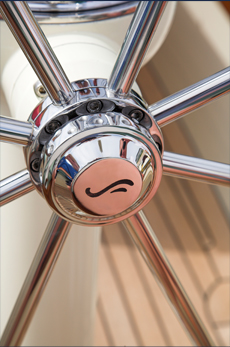About Us

Appendages
A discussion on performance of Fontaine designs cannot be complete without looking closely at centerboard and rudder configurations. The general theory of sailing demonstrates that the wind over the sails creates a force that pushes the boat both forward and to leeward when sailing upwind. The resistance to leeway, or slipping sideways, is determined by the total profile area, or lateral plane, below the waterline and the shape of the hull and appendages.
It has been proven in one-design dinghies and the new America's Cup Class that a thin keel or centerboard is fast. In fact, some classes have strict rules against modifying them below a minimum thickness. In addition, designers have learned that deeper, narrow (fore and aft) appendages are a more efficient foil, or “wing”, for developing a lifting force to windward. A good analogy to this can be seen in the long, narrow wing designs of gliders capable of producing tremendous lift at lower speeds. Experiments have proven that a higher aspect ratio appendage produces more lift for a given area than a more square profile.
A typical racing boat today confirms this trend towards deep, narrow appendages. However, a 40’ sailboat with a fixed, deep-draft keel with 7’ or 8’ of draft has limited appeal to any cruising sailor. A common solution for a cruiser/racer is to reduce the draft of the keel, make it thicker or longer fore and aft to provide volume for lead, and/or add wings or bulbs to the bottom to lower the center of gravity of the lead. This is a compromise that greatly reduces the upwind performance of the boat.
A Fontaine designed keel/centerboard or “Delta form” hull has all internal lead ballast so that the centerboard is not heavy and can be easily raised with a simple and reliable mechanism. There is no restriction to the depth, width or thickness of the centerboard since it can be raised in shallow waters and does not have to have volume for lead ballast. We are free to optimize the section shape and aspect ratio of the centerboard to provide the maximum amount of lift.
There have also been great efforts made to improve the transition between the hull and the keel or centerboard so that the water flow remains smooth when sailing upwind. This is most evident in the recent race boat designs where the keel is extremely narrow, both fore and aft, in the section where it meets the hull. Again, this is fine for the extreme racing sailor, but difficult and costly on a typical cruising boat because of the engineering and construction challenge of supporting a heavy keel on such a small area. Our centerboard designs, particularly the “Delta form” version, provide this clean transition without engineering concerns.
